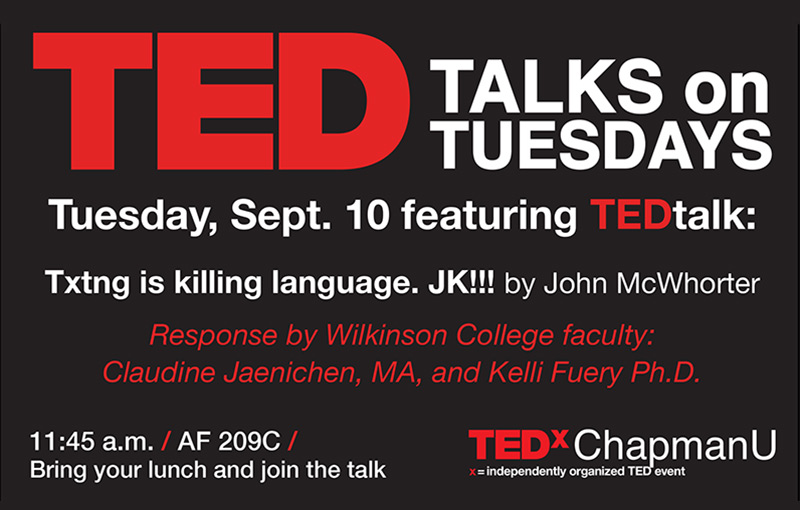If you read my recent post about TED Talk Tuesday at Chapman, I only discussed my response to the speaker. However we were fortunate enough to have two Chapman professors provide their insight and feedback – Claudine Jaenichen and Kelli Fuery.
Claudine began with a discussion about how we interpret the actual visual aspect of texting. She touched on how people use emojis, smileys, capitol letters, punctuation, and formatting to convey a message. For example, the use of “LOL” and “haha” have evolved over the years. Instead of simply meaning literally “laughing out loud,” “LOL” stands for empathy or a marker of interest. “haha” lightens the tone of a message and indicates that something was amusing, not necessarily something you actually laughed at. We use ALL CAPS to signal excitement or anger. We add in smiley faces and emojis to attempt to portray a facial expression, body language, tone, or feeling. When the communication is simply visual, we create this whole new strategy for portraying our actual attitude. In addition, she highlighted how the language you use varies based on your relationship with the reciever as well as the status/job/personality of the receiver of the message. For example, a parent may appreciate a message such as “Hello! How are you?” whereas a close friend may expect a message such as “hey how r u” – it all depends on who the audience is.
Kelli explained how she had issue with the assumption that “texters” are generally youth. When asked for a raise of hands of who texts, all but one person in the room had their hands in the air. The audience was filled with people of every age group and background. She emphasized that it’s important to not associate texting only with youth because other generations use it as well – meaning a wide variety of strategies, styles, and audiences. John McWhorter explained that speech tends to be looser, more telegraphic, and less reflective. She believes that yes, speech is less reflective, however it is much more genuine, authentic, and natural. It does not make sense to apply formal grammar rules to something so informal such as texting and speech. Texting is a new form of visual communication, not a degradation of language. Both formal and informal writing have their appropriate places and share an equal importance.


